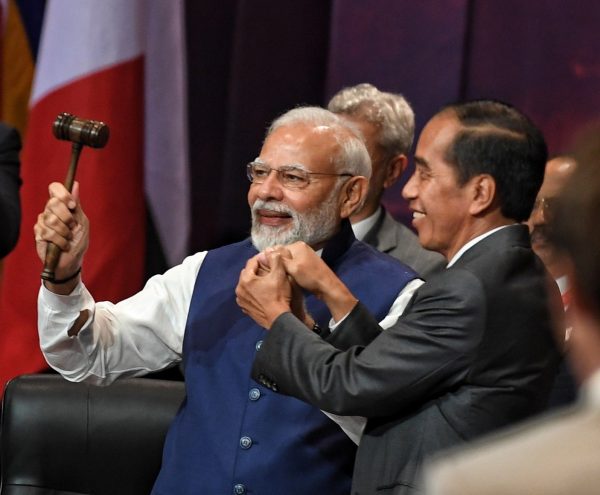In the realm of global politics, leaders often emerge from diverse backgrounds, each with their own unique narrative. However, there are instances when leaders from seemingly different corners of the world share striking similarities in their trajectories and policy objectives. Such is the case with Prime Minister Narendra Modi of India and President Joko “Jokowi” Widodo of Indonesia, whose humble beginnings and common developmental pursuits have shaped their respective leadership journeys.
Both Modi and Jokowi hail from modest backgrounds, a factor that resonates deeply with their respective electorates. Modi, born into a humble family of tea sellers in the western Indian state of Gujarat, and Jokowi, whose upbringing in a riverside town in Central Java was far removed from the corridors of power, have experienced firsthand the challenges of economic hardship. This shared heritage has endowed them with an empathy that has informed their governance styles.
One striking parallel in their leadership is their unwavering commitment to economic development, with a particular focus on manufacturing and infrastructure. Modi’s “Make in India” campaign and Jokowi’s “Making Indonesia 4.0” vision both underline the pivotal role of manufacturing in their respective nations’ growth stories. The intention is clear: to boost domestic production, create jobs, and elevate their countries to the status of global manufacturing hubs.
Infrastructure development is another arena where Modi and Jokowi exhibit striking parallels. Both leaders have launched ambitious infrastructure projects to modernize their nations. In India, the “Smart Cities Mission” and the “Bharatmala Pariyojana” are aimed at improving urban infrastructure and connectivity. Meanwhile, Indonesia’s “National Strategic Projects” focus on transportation, energy, and tourism infrastructure. These initiatives reflect their shared aspiration to enhance the quality of life for their citizens and stimulate economic growth.
Diplomat Brief
Weekly Newsletter
Get briefed on the story of the week, and developing stories to watch across the Asia-Pacific.
Get the Newsletter
Furthermore, both leaders recognize the importance of digitalization and technological advancement in the contemporary world. Modi’s “Digital India” and Jokowi’s “Making Indonesia 4.0” initiatives underscore their commitment to harnessing the power of technology to drive economic progress and increase global competitiveness. In an era defined by rapid technological change, their efforts to nurture innovation and digital infrastructure demonstrate their forward-looking vision.
Moreover, from the recent G-20 summit, it is evident that while high-level policy decisions have kicked off between the two leaders in the last few years, the high trade numbers and increasing investment are clear indicators of the rise in affinity that is being seen at the business-to-business and even government-to-government levels. The growing bilateral relations between India and Indonesia are a testament to the collaborative spirit fostered by Modi and Jokowi, who recognize the mutual benefits of enhanced cooperation in trade, investment, and technology exchange.
However, it is essential to acknowledge that despite these parallels, Modi and Jokowi lead two vastly different nations, each with its unique challenges and opportunities. India, as one of the world’s most populous countries, grapples with issues of scale and complexity that are unparalleled. Indonesia, on the other hand, faces the challenge of uniting its vast archipelago and diversifying its economy beyond commodities. Furthermore, Jokowi has encouraged the value-add production of nickel by banning the export of the raw material. This is set to increase the revenue that Indonesia derives from its abundant nickel reserves and encourage industries to process the ore domestically.
Additionally, their approaches to governance differ in significant ways. Modi’s leadership is often characterized by a more centralized and top-down style, with a strong emphasis on the political ideology of Hindutva, which equates Indian national identity with Hinduism and has resulted in discrimination against religious minorities, particularly Muslims. In contrast, Jokowi has shown much more respect for the idea of a multi-ethnic and multi-religious Indonesia than Modi has done with respect to India. His style is also more pragmatic and hands-on, with a focus on problem-solving and economic development.
Advertisement
Moreover, the foreign policy orientations of the two leaders diverge. Modi has pursued a more assertive and strategic foreign policy, seeking to strengthen India’s role on the global stage and cultivate alliances with key players. Jokowi, on the other hand, has adopted a more non-aligned, inward-looking approach, emphasizing Indonesia’s sovereignty and regional leadership within Southeast Asia.
In a nutshell, the parallel trajectories of Prime Minister Narendra Modi and President Joko Widodo, from humble beginnings to positions of global leadership, offer an intriguing case study in leadership and development. Their shared commitment to manufacturing, infrastructure development, and technology reflects a common understanding of the pressing challenges facing their nations. Yet, their distinctive approaches and the unique contexts of India and Indonesia highlight the rich diversity within global leadership. As these two leaders continue to shape the destinies of their nations and nurture their growing bilateral relations, the world watches with keen interest, observing how their shared objectives and differing styles contribute to the development of two of Asia’s largest democracies and the strengthening of ties between their nations.

